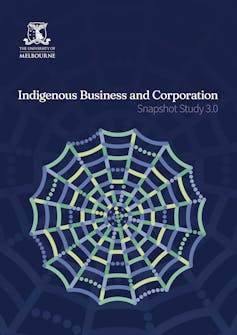Source: The Conversation (Au and NZ) – By Michelle Evans, Associate Professor, The University of Melbourne
Indigenous businesses generate about A$16 billion a year in revenue and employ more than 116,000 people – almost as many as the massive Coles retail group.
But the contribution of these businesses to the Australian economy has long been underestimated.
This is despite Indigenous businesses delivering, among other things, important culturally sensitive health and education assistance in remote areas, professional and technical services to the mining industry and cultural training to corporations and government.
While all this work creates income and promotes economic self-determination for business owners and their employees, much of it is done out of sight without being properly identified in government statistics.

Dilin Duwa Centre
Better integrating data
The Indigenous Business and Corporation Snapshot from the Dilin Duwa Centre for Indigenous Business Leadership at the University of Melbourne breaks new ground.It is the most comprehensive longitudinal study of Indigenous entrepreneurial activity undertaken, examining 13,693 businesses operating in 2022, with the potential to capture data from more businesses in the future.
The snapshot integrates information from Indigenous business registries with the Australian Bureau of Statistics Business Longitudinal Analysis Data (BLADE) registry.
In this year’s 2022 snapshot, the third, we have for the first time included businesses that don’t identify as Indigenous by locating sole traders and partnerships with at least 50% Indigenous owners.
This is important because as sole traders and in partnerships often provide future Indigenous business leaders with their skills and trade.
Identifying as Indigenous seems to help
An analysis of COVID survival rates up to 2021-22 included in the snapshot found businesses that identified as Indigenous by registering on the Indigenous business registry were more likely to have survived than those that did not.
This seems to be because they were larger, more likely to be located in rural and remote areas less affected by lockdowns, and had better access to the JobKeeper and in some cases better access to procurement contracts.
Smaller sole traders, many of whom did not register as Indigenous, might have faced problems running a business during COVID while caring for family.
These findings point to the importance of providing support for sole traders and smaller partnerships with low incomes even if they are not registered as Indigenous.
More data needed
Still more work is needed to understand the Indigenous business sector. Our study provides only a partial representation because it still does not capture private and publicly-listed Indigenous companies that are not registered as Indigenous companies.
The Bureau of Statistics might be able to help by providing more data on the owners of these companies.
Without such information and a public profile, it is hard for Indigenous businesses to gain the recognition and trust needed to attract finance to enable growth.
If COVID has taught us anything, it is that complete and readily available data about businesses helps us understand what is happening on the ground and gives us feedback on the effectiveness of support.
Read more:
New research shows how Indigenous-owned businesses are creating better outcomes for their employees
![]()
Michelle Evans receives funding from the Australian Research Council.
Cain Polidano receives funding from Australian Research Council.
– ref. Indigenous businesses are worth billions but we don’t know enough about them – https://theconversation.com/indigenous-businesses-are-worth-billions-but-we-dont-know-enough-about-them-227677







